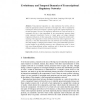Free Online Productivity Tools
i2Speak
i2Symbol
i2OCR
iTex2Img
iWeb2Print
iWeb2Shot
i2Type
iPdf2Split
iPdf2Merge
i2Bopomofo
i2Arabic
i2Style
i2Image
i2PDF
iLatex2Rtf
Sci2ools
BIOWIRE
2007
Springer
2007
Springer
Evolutionary and Temporal Dynamics of Transcriptional Regulatory Networks
Transcriptional regulation is a key mechanism that allows cells to make the appropriate amount of proteins at the right time. This is mediated by transcription factors that respond to specific signals and regulate expression of the relevant genes. The set of all regulatory interactions in a cell can now be investigated and this is best represented as the transcriptional network where nodes represent transcription factors or target genes and edges represent regulatory interactions. In this manuscript, I will first discuss the current understanding of the organization of such networks from the model organisms E. coli and yeast. I will then demonstrate that such networks are extremely dynamic and adapt rapidly to changing environments. This will be illustrated by discussing the changes in the network structure in two different time scales: (i) those that occur during different cellular conditions and (ii) those that occur across different organisms living in diverse environments.
BIOWIRE 2007 | Communications | Nodes Represent Transcription | Regulatory Interactions | Transcription Factors |
| Added | 07 Jun 2010 |
| Updated | 07 Jun 2010 |
| Type | Conference |
| Year | 2007 |
| Where | BIOWIRE |
| Authors | M. Madan Babu |
Comments (0)

